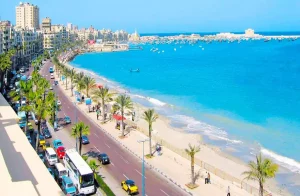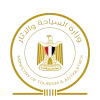Alexandria

Alexandria has a wealthy geographical situation in the north of Egypt. It is between the Mediterranean Sea and Lake Mariut (Mareotis). The city is 221 km far to the northwest of Cairo. Alexandria was founded by Alexander the Great in 331 BC. It became the capital of Egypt for about ten centuries.
After the Islamic conquest in 642 AD, it became the second city. Unfortunately, it lost much of its importance as the first port. At that time, the nearby town of Rosetta was the first port of Egypt.
Alexandria in the XIX and till now
Thanks to Mohamed Ali, who gave care to Alexandria. During his reign, the city recovered again. Its strategic, economic, and cultural values reappeared again and are still today. It is called by the Egyptians the ‘Mediterranean Bride’ in Arabic Arous Al-Bahr.
The city is the second most impressive city in Egypt. Its importance comes from its historical value and industrial development. Alexandria has lovely beaches and resorts. These beaches serve thousands of local and foreign tourists. Nowadays, the city has about four million inhabitants. Most of the Alexandrian monuments belong to the Greco-Roman Eras. In addition, there are some antiquities from the Christian and Islamic eras.
The city during the Christian Period
Moreover, it was the first center of Christianity in Egypt. The city received the first emanations of the Christian faith around the middle of the first century A.D. by Saint Mark. Therefore, It still has some of the most important churches in the country. In Ancient times, Alexandria was a very prosperous city with impressive landmarks. Most parts of its ancient antiquities and monuments disappeared as the Lighthouse. It was one of the Seven Wonders of the ancient world, the Old Library, and others.
Now the city is the capital of Alexandria Governorate. It was always an immigration center, particularly from the countryside and inner parts. It helped prosperous its economy.
Antiquities and Monuments of Alexandria
Many of Alexandria’s monuments disappeared due to natural erosion, the advance of the sea, and rain. There was destruction because of political and religious disturbances, riots, and revolts throughout the ages. In addition to That, bad urbanization occurred in some parts of the city.
Many historical sites and antiquities spreads in the city. The cemeteries of Romans as the Kom Al Chuqafa Catacombs and Silvago tombs are ancient. There are the Roman Theater and its Opened-Air Museum, the Temple of Al-Ras Al Soda, and Pompey’s Pillar.
The Greco-Roman Museum has a great collection that dates back to the Greco-Roman and Christian eras. Therefore, there are various museums of various types. The National Museum contains many antiquities from the ancient Egyptian period, the Greco-Roman time, Christian and Islamic ages. Besides, there is an entire section dedicated to Modern times till the middle of the 20th Century. One of the most important museums in the city is the Royal Jewelry Museum which exhibits collections of the jewelry of the Royal family of Egypt.
Alexandria has a number of historic mosques from the Islamic Era between the 14th and 19th centuries. One of the most important mosques is Al Mursi Abu El Abbas. As a postcard of the modern city the Quitabai Fort. It is located on the Mediterranean coast, in the small Pharos peninsula. The fort was built on the foundation of the Lighthouse of Alexandria in the 15th Century.





